Наклеивание на стены обоев – практически единственный в прошлом способ украсить стены своего дома или квартиры. В настоящее время возможности для отделки стен и потолка различными материалами значительно расширились. Но поклейка обоев на стены не теряет своей привлекательности и популярности за счет относительной дешевизны и простоте исполнения. К тому же значительно расширился ассортимент, качество и разнообразие в материалах, из которых изготовлены обои.
Порядок провидения работ
Изменился и способ подготовки стен и потолка под финишную отделку. Если раньше знали лишь грубое оштукатуривание стен песчано-цементной смесью, то сейчас на первое место выходит выравнивание стен при помощи гипсокартонных листов. Такие стены представляют собой идеально ровную поверхность, на которую без особых проблем ложатся обои любых видов и расцветок. Подготовка стен из гипсокартона к поклейке обоев возможна без привлечения к этому процессу профессионалов.
Выравнивание стен и потолков при помощи ГКЛ известно в нашей стране относительно недавно, но уже успело приобрести вполне заслуженную популярность. Суть этого способа в создании каркаса из металлопрофиля с последующим прикреплением к нему листов гипсокартона. Такой метод позволяет создавать практически идеально ровные стены и потолок, спрятать за ними всевозможные трубы, провода, системы вентиляции и прочие объекты. К тому же гипсокартон обладает рядом положительных факторов, что делает применение ГКЛ во внутренней отделке просто незаменимым.
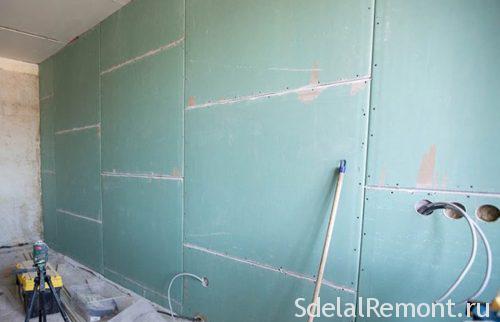
Но обшить стены и потолок гипсокартоном мало, нужно ещё правильно подготовить их к последующей поклейке обоями. Тогда ваши обои будут крепко держаться, красиво выглядеть и легко демонтироваться перед следующим ремонтом. Справится c этой задачей несложно, потому что все необходимые для работы материалы есть в любом строительном супермаркете. Единственное, что нужно – не пренебрегать последовательностью выполнения работы. О том, как подготовить стену из гипсокартона к поклейке обоев, мы и поговорим ниже.
Нужно ли грунтовать гипсокартон перед поклейкой обоев?
В принципе, грунтовка любой поверхности просто необходима. Она служит для укрепления обрабатываемой поверхности и повышению сцепляемости с другими материалами при последующей отделке. Для обработки гипсокартона перед поклейкой обоев выбирают обычно проникающую грунтовку, которая сможет не только укрепить хрупкий гипс, но и повысит его агдезионные свойства. Кроме этого многие грунтовки препятствуют образованию гнили и плесени, хорошо пропускают воздух, после высыхания не боятся влаги.
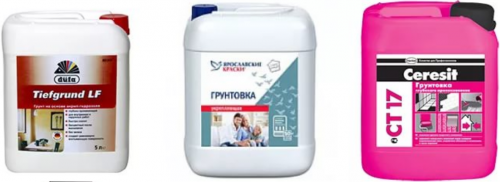
В последнее время широкое распространение получили грунтовки на акриловой основе. Предпочтение отдаются обычно европейским фирмам, таким как товары которых известны по всему миру.
Не старайтесь экономить на мелочах. Если вы хотите получить качественный ремонт – выбирайте качественные отделочные материалы.
Вопрос: чем грунтовать гипсокартон перед поклейкой обоев? Принципиально неважно какой именно фирмы использовать грунтовку, главное тщательно обработать поверхность. Остальное, как говорится, дело техники.
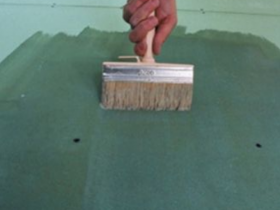
Наносится грунтовка очень легко, с этим справится даже ребенок. Для работы понадобится:
- малярный валик;
- неширокая кисть для обработки стыков;
- ванночка для состава.
Сначала грунтуются углы, шляпки саморезов и стыки листов гипса. После высыхания (время высыхания обычно пишется на упаковке) валиком наносится новый слой на всю поверхность стен.
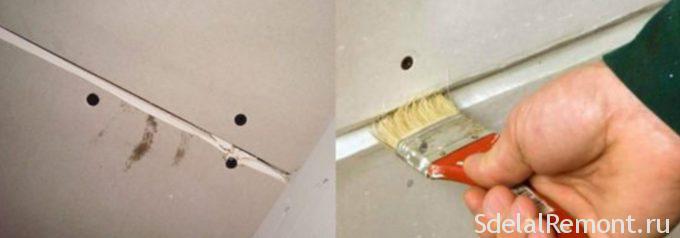
Расход грунтовки обычно невысок, но забывать про нее не стоит. Оставшийся состав можно использовать ещё раз, перед поклейкой обоев. Здесь очень хорошо подойдет принцип: «Много – не мало!»
Как подготовить стены к наклеиванию обоев
Итак, грунтовка подсохла и пришла пора заделать все неровности, царапины и щели между листами. Для этого стоит приобрести специальные составы, носящие общее название «шпаклевка». Для ГКЛ выпускаются смеси на основе гипса, которые делятся на сухие и готовые, стартовые и финишные. Для тех, кто не имел дела с подобными работами раньше, предпочтительно покупать сухие смеси. Готовая шпаклевка обычно быстро схватывается, и неопытный человек не успеет использовать её полностью. А сухую смесь можно разводить малыми порциями.
Поклейка обоев на гипсокартон без шпаклевки не желательна. В случае нового ремонта старые обои придется удалять. Часто в таких случаях вместе с обоями отрывается бумажный слой ГКЛ. Это грозит заменой поврежденного листа гипсокартона и, как следствие, увеличением времени и стоимости самого ремонта. Поэтому опытные заказчики не жалеют времени и денег на полноценную отделку всех стен из ГКЛ, чем сразу выполнять оклейку обоев на гипсокартон без шпаклевки, а потом мучатся при снятии обоев о стены.
Для работы нужно приобрести удобные шпателя разной ширины. Один из них маленький, 5-7 см, служит для набирания шпатлевки из емкости, заделки небольших повреждений картона и прочих вспомогательных работ. Специальная смесь наносится на стыки гипсокартона.
Обычно шпаклевка стен из гипсокартона под обои делается стартовой шпаклевкой. Финишную наносят в том случае, когда стены красятся различными водоэмульсионными красками и нужна очень чистая и гладкая поверхность. Для обработки всей поверхности листа одного тонкого слоя будет вполне достаточно. Готовые финишные смеси стоят дороже, поэтому часто используют сухие составы.
Сухую смесь разводят нужным количеством воды в небольшом чистом, пластиковом ведерке. Желательно для этой цели иметь дрель и специальную насадку-миксер. Соотношение воды и шпатлевки написано обычно на упаковке либо в инструкции к применению.
В первую очередь заделываются:
- углубления от шляпок саморезов;
- порезы и вмятины на поверхности смонтированных листов;
- щели на стыках ГКЛ.
Углубления от шляпок шурупов заделываются узким шпателем крестообразными движениями. Щели стыков требуют большего внимания. Сначала из забивают шпаклевкой, затем накладывают армирующую ленту (серпянку), слегка утапливая её в смесь. Излишки разравниваются широким шпателем, остатки со шпателя удаляются. В итоге стены примут такой вид, как на фото ниже.
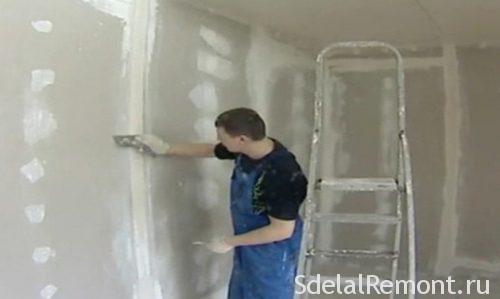
После того, как слой шпаклевки подсохнет, можно заделывать всю поверхность стен. Слой смеси должен быть не толще 1 – 2 мм. Он наносится широким шпателем длинными круговыми движениями. Следите, чтобы поверхность содержала как можно меньше неровностей.
Не пытайтесь сразу сделать стену идеально ровной и гладкой. Все бугорки и шероховатости удаляются после высыхания слоя.
После того, как слой шпатлевки высохнет, можно нанести второй, корректирующий слой. Подробно, как правильно шпаклевать гипсокартон и тонкостях выполнения работ.
Если на ваш взгляд отделка сделана нормально, можно приступать к окончательно обработке поверхности. Она заключается в ошкуривании стены для удаления мелких неровностей. При этом образуется большое количество мелкодисперсной пыли, так что применение средств защиты в виде очков, респираторов или ватно-марлевых повязок обязательно!
Для подобных операций в продаже есть терки с держателями, в которых крепится мелкая наждачная шкурка или абразивная сеточка. Пожалуй, это самый неприятный момент при подготовке гипсокартона к поклейке обоев.
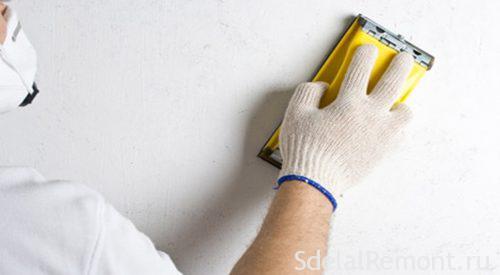
И последний штрих – обработать гипсокартон перед поклейкой обоев грунтовкой. Многим этот шаг покажется лишним. Но на самом деле проникающая акриловая пропитка после высыхания сократит расход клея, обеспечит прочное соединение обоев со стеной и позволит впоследствии демонтировать обои без особых последствий для стены. В дополнение ознакомьтесь, как подготовить обычные стены к обоям.
Выбор обоев для стен
Итак, пройдены все этапы обработки стен из гипсокартона. Впереди финальное испытание – поклейка обоев на гипсокартон. Технология этого процесса стара, как мир. Изменились лишь материалы, из которых изготавливают этот вид отделки помещений, да расширился спектр цветов и рисунков. Появились моющиеся обои, обои с рельефным рисунком, тканевые и фотообои.
По способу изготовления обои подразделяются на виды:
- бумажные;
- флизелиновые;
- виниловые;
- акриловые;
- текстильные.
Каждый вид имеет свои преимущества и недостатки по отношению к другим. Но какие бы обои вы не выбрали, они очень легко и естественно лягут на тщательно подготовленную поверхность гипсокартонных стен. И значит, все труды не пропали напрасно. Далее можно приступать непосредственно к оклейке обоев.












